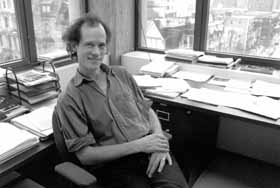
| ||
 | ||
 Superconductivity expert Louis Taillefer PHOTO: OWEN EGAN |
Sparks are flying for Steacie winner
|
SHAUN GOHO | On February 10th, in Ottawa, the Natural Sciences and Engineering Research Council of Canada (NSERC) announced that McGill physics professor Louis Taillefer would be awarded a 1998 E. W. R. Steacie Memorial Fellowship.
Steacie Fellowships are granted to young researchers who have garnered international attention for achievements in their field of science or engineering. Only four such fellowships are granted each year. Taillefer is the fourth McGill recipient of the award since 1990. Taillefer, recipient of a 1993 Sloan Fellowship as a young scientist of "exceptional promise," works in the exciting new field of unconventional superconductivity. Superconductivity, which physicist David Pines has called "perhaps the most remarkable physical property in the universe," is when a wire or circuit carries an electrical current without resistance. First discovered in 1911, the phenomenon only occurs in certain materials, and then only when they are cooled below a critical temperature. Superconductors can carry large currents of electricity and make powerful electromagnets. Machines such as magnetic resonance imaging (MRI) body scanners are based on them. However, the widespread application of superconductors was long hindered by the great cost of cooling them to the extremely low temperatures at which their properties emerged. Until about 10 years ago, all known superconductors had to be cooled to within a few degrees of absolute zero. However, in a flurry of discovery, one new material after another has been found which increases the highest known temperature at which superconductivity occurs. One consequence of the discovery of these unconventional superconductors is that the process of cooling has become much cheaper, thus making practical applications more feasible. Taillefer focuses his research not on the applications of superconductors, but rather on understanding how they work. "The mechanism for these new materials to become superconductors is not the conventional mechanism that we have in aluminum or lead in standard superconductors," he explains. "My own research, and much of the current interest in this field, is concerned with trying to understand the fundamental questions about the mechanism behind these new superconducting states." Taillefer believes the best way to understand the properties of superconductors is not to keep searching for new ones, but to focus on a few. "I tend to work on carefully selecting a few compounds and then studying these in depth," he says. A skilled experimenter, he is known for developing new techniques and for his ability to produce remarkably pure, high-quality crystals of the superconductors he studies. "I put a lot of emphasis on the quality of my samples," he explains. "It turns out that a lot of the early work [on unusual superconductors] was not very useful because it was carried out on poorly characterized, not very pure samples." Taillefer's work is gaining him a high profile in the international scientific community. In 1997 alone, he published five papers in Physical Review Letters, one of the most prestigious journals in his field, and another in Nature. Now his successes have led to the Steacie Fellowship, which will provide McGill with the full amount of Taillefer's salary for up to two years, and allow him to obtain significant new research funding from NSERC. For Taillefer, the award could not have come at a better time. After several years spent setting up his lab and gathering collaborators around him, everything is now "running at full speed," says Taillefer. "It's an exciting time; a lot of experiments are being immediately planned in all directions. Things are going very well in the group at the moment." Taillefer credits his success to the "outstanding research associates" he has worked with, and to the support he has received from many funding bodies and organizations, especially the Canadian Institute for Advanced Research, which, through its Superconductivity Program, has supported his work and put him in contact with other superconductivity researchers across Canada. The 1998 Steacie Memorial Fellowships will be presented in a ceremony in Ottawa at the end of April.
|
|
| |||||